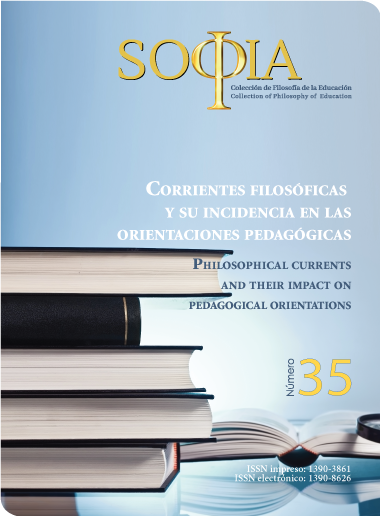Use of paradoxes as didactic resources that develop critical thinking in students
Main Article Content
Abstract
Article Details

This work is licensed under a Creative Commons Attribution-NonCommercial-ShareAlike 4.0 International License.
Authorship: The list of authors signing must include only those people who have contributed intellectually to the development of the work. Collaboration in the collection of data is not, by itself, a sufficient criterion of authorship. "Sophia" declines any responsibility for possible conflicts arising from the authorship of the works that are published.
Copyright: The Salesian Polytechnic University preserves the copyrights of the published articles, and favors and allows their reuse under the Creative Commons Attribution-NonCommercial-ShareAlike 3.0 Ecuador license. They may be copied, used, disseminated, transmitted and publicly displayed, provided that: i) the authorship and the original source of their publication (journal, editorial and work URL) are cited; (Ii) are not used for commercial purposes; Iii) mention the existence and specifications of this license.
References
Anselmo. (1998). Proslogion. Madrid: Tecnos.
Argote, José. (6 de abril del 2013). Polvo de Cantor. Mundo fractal.
http://www.asociacionceat.org/aw/2/polvo_de_cantor.htm
Aristóteles (1994). Metafísica. Madrid: Gredos.
Aristóteles (1995). Física. Madrid: Gredos.
Artosi, Alberto; Pieri, Bernardo y Sartor, Giovanni (2013) Leibniz: Logico-Philosophical Puzzles in the Law. Philosophical Questions and Perplexing Cases in the Law. Heidelberg: Springer.
Barjavel, René. (1944). Le Voyageur Imprudent. París: Denoël.
Brooks, Jacqueline y Brooks, Martin (1999). In search of understanding: The case for constructivist classrooms. Alexandria, VA: Association for Supervision and Curriculum Development.
Clark, Michael. (2009). El gran libro de las paradojas. Madrid: Gredos.
Copi, Irving y Cohen, Carl. (2001). Introducción a la lógica. México: Limusa.
Escribano, Alicia y Del Valle, Ángela. (coords.) (2008). El aprendizaje basado en problemas. Una propuesta metodológica en Educación Superior. Madrid: Narcea
Galilei, Galileo. (1945). Diálogos acerca de dos nuevas ciencias. Buenos Aires: Losada.
Garcíadiego, Alejandro. (1992). Bertrand Russell y los orígenes de las “paradojas” de la teoría de conjuntos. Madrid: Alianza Editorial.
Gea, María; Batanero, Carmen; Contreras, José y Arteaga, Pedro (2017). Paradojas como recurso didáctico en la enseñanza de la probabilidad. En Serna, Luis Arturo (Ed.), Acta Latinoamericana de Matemática Educativa, pp. 385-393, México, DF: Comité Latinoamericano de Matemática Educativa. http://funes.uniandes.edu.co/12165/1/Gea2017Paradojas.pdf
Gestión. (3 de diciembre del 2019). Perú mejora en prueba PISA 2018, pero sigue último entre los países de la región. Gestión. https://gestion.pe/peru/peru-mejora-en-prueba-pisa-2018-pero-sigue-ultimo-entre-los-paises-de-la-region-nndc-noticia/
Hickson, Michael (2014). A Brief History of Problems of Evil. En: McBrayer, J. P.; Howard-Snyder, D. The Blackwell Companion to The Problem of Evil. Wiley-Blackwell, pp. 26–27.
Hilbert, David. (2013). David Hilbert’s Lectures on the Foundations of Arithmetics and Logic 1917- 1933. William Ewald and Wilfried Sieg (eds.). Springer-Verlag.
Laercio, Diógenes. (1985). Vidas, opiniones y sentencias de los Filósofos más ilustres. Barcelona: Teorema.
Lactancio. (2014). La obra creadora de Dios. La ira de Dios. Madrid: Editorial Ciudad Nueva.
Leibniz, G. (2013). Ensayos de Teodicea. Sobre la bondad de Dios, la libertad del hombre y el origen del mal. Salamanca: Editorial Sígueme.
Mandelbrot, Benoît. (1983). La geometría fractal de la naturaleza. Barcelona: Tusquets.
Manzanares, Asunción. (2008). Sobre el Aprendizaje Basado en Problemas (ABP). Escribano, Alicia y Del Valle, Ángela (coords.) El Aprendizaje Basado en Probelmas. Una propuesta metodológica en Educación Superior. Madrid: Narcea, pp. 14-23.
Mora, Rafael. (2019). La paradoja de Aquiles y la tortuga como una falacia del continuo. Tesis. Año 13, 12(15), 43-62. Disponible en: https://revistasinvestigacion.unmsm.edu.pe/index.php/tesis/article/view/18820/15801?fbclid=IwAR0w685rs-Yv4eLT7MjZumHiOiLcU6GaRgkTYZ1p8qso67er6Fh39bIEguk
Northrop, Eugene. (1949). Paradojas Matemáticas. México: UTEHA.
Olexandrgodomich. (2022). Pasos de construcción del triángulo de Sierpinski. Dreamstime.com. https://es.dreamstime.com/pasos-de-construcci%C3%B3n-del-tri%C3%A1ngulo-sierpinski-evoluci%C3%B3n-la-junta-matem%C3%A1tica-geom%C3%A9trica-interminable-fractal-pir%C3%A1mide-con-un-image228018226
Plutarco. (1987). Obras morales y de costumbres (Moralia). IV. Charlas de Sobremesa. Madrid: Gredos.
Rawls, John. (2006). Teoría de la justicia. México: FCE.
Rosas, Patricia, Acosta, Ricardo y Aguilar, Julio (2018). Diálogo abierto. Guadalajara: Universidad de Guadalajara.
Russell, Bertrand. (1983). Los principios de la matemática. Madrid: Espasa-Calpe.
Sánchez, Roberto. (2022). La historia de la geometría. Robertosnchz. https://robertosnchz.blogspot.com/2020/07/historia-de-la-geometria-la-historia-de.html
Savage, Wade. (1967). The Paradox of the Stone. Philosophical Review, Vol. 76, No. 1, pp. 74–79 https://doi.org/10.2307/2182966
Savater, Fernando. (2008). La aventura de pensar. Barcelona: Random House Mondadori.
Schunk, Dale. (2012). Teorías del aprendizaje. México: Pearson Educación.
Selvin, Steve (1975). A problem in probability (letter to the editor). The American Statistician. 29 (1): 67–71. https://doi.org/10.1080/00031305.1975.10479121
Solé, Isabel y Coll, César. (1995). Los profesores y la concepción constructivista. En: Coll, C.; Martín, E.; Mauri, T.; Miras, M.; Onrubia, J.; Solé, I. y Zabala, A. El constructivismo en el aula. Barcelona: Graó, pp. 7-24.

